Managing Financial Resources in Health & Social Care: Pennine Care
VerifiedAdded on 2024/05/20
|23
|4584
|61
Report
AI Summary
This report provides a comprehensive analysis of managing financial resources within the health and social care sector, focusing on costing principles, business control systems, and regulatory requirements. It identifies the information needed for effective financial management, including asset details, income data, market trends, and legal rules, using the Pennine Care NHS Foundation Trust as a case study. The report also discusses various income sources available to health and social care organizations, analyzes factors influencing financial resource availability, and reviews different types of budget expenditure, such as departmental, project, sales, and capital budgets. Ultimately, the report emphasizes the importance of sound financial management practices and adherence to legal frameworks for the success and sustainability of healthcare organizations.
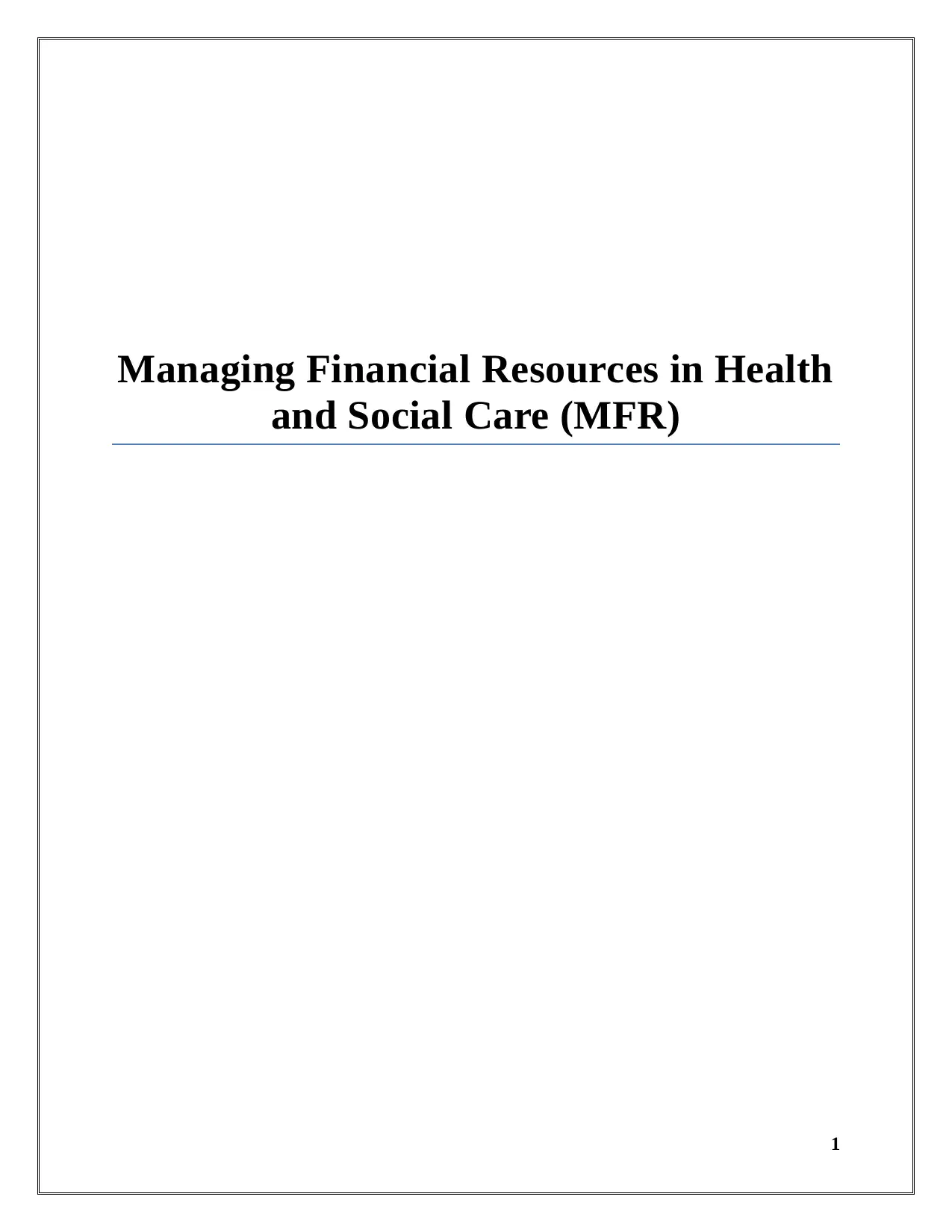
Managing Financial Resources in Health
and Social Care (MFR)
1
and Social Care (MFR)
1
Paraphrase This Document
Need a fresh take? Get an instant paraphrase of this document with our AI Paraphraser
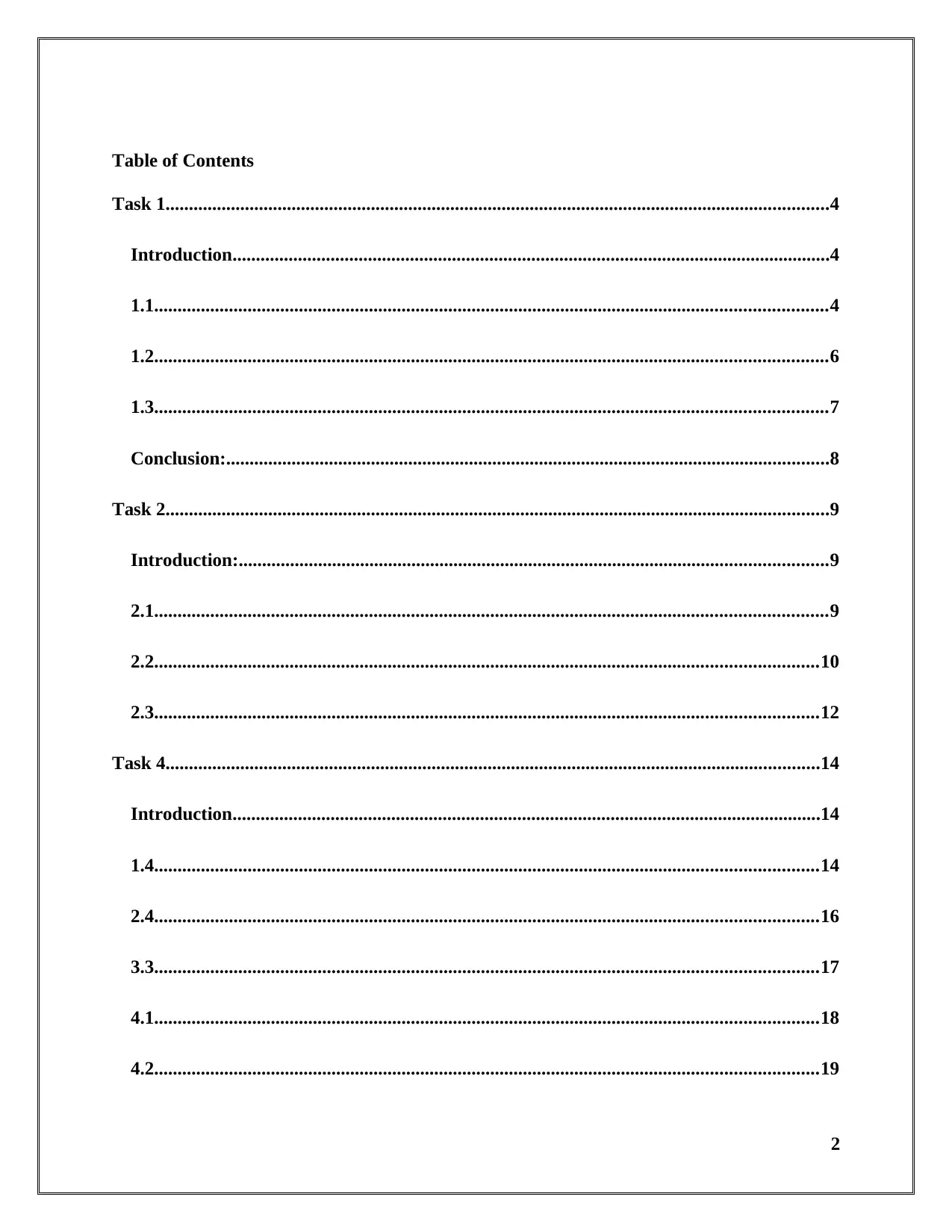
Table of Contents
Task 1..............................................................................................................................................4
Introduction................................................................................................................................4
1.1................................................................................................................................................4
1.2................................................................................................................................................6
1.3................................................................................................................................................7
Conclusion:.................................................................................................................................8
Task 2..............................................................................................................................................9
Introduction:..............................................................................................................................9
2.1................................................................................................................................................9
2.2..............................................................................................................................................10
2.3..............................................................................................................................................12
Task 4............................................................................................................................................14
Introduction..............................................................................................................................14
1.4..............................................................................................................................................14
2.4..............................................................................................................................................16
3.3..............................................................................................................................................17
4.1..............................................................................................................................................18
4.2..............................................................................................................................................19
2
Task 1..............................................................................................................................................4
Introduction................................................................................................................................4
1.1................................................................................................................................................4
1.2................................................................................................................................................6
1.3................................................................................................................................................7
Conclusion:.................................................................................................................................8
Task 2..............................................................................................................................................9
Introduction:..............................................................................................................................9
2.1................................................................................................................................................9
2.2..............................................................................................................................................10
2.3..............................................................................................................................................12
Task 4............................................................................................................................................14
Introduction..............................................................................................................................14
1.4..............................................................................................................................................14
2.4..............................................................................................................................................16
3.3..............................................................................................................................................17
4.1..............................................................................................................................................18
4.2..............................................................................................................................................19
2
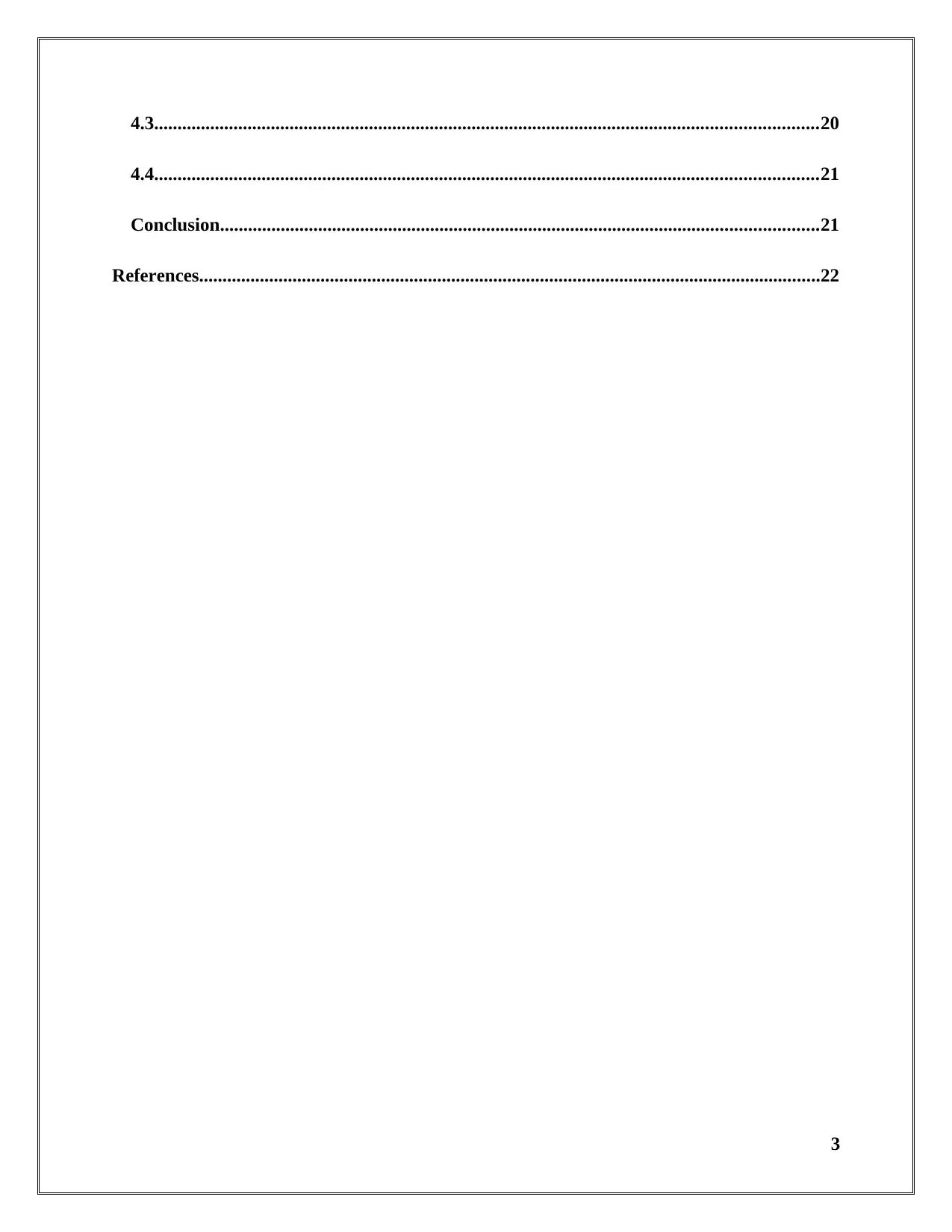
4.3..............................................................................................................................................20
4.4..............................................................................................................................................21
Conclusion................................................................................................................................21
References.....................................................................................................................................22
3
4.4..............................................................................................................................................21
Conclusion................................................................................................................................21
References.....................................................................................................................................22
3
⊘ This is a preview!⊘
Do you want full access?
Subscribe today to unlock all pages.

Trusted by 1+ million students worldwide
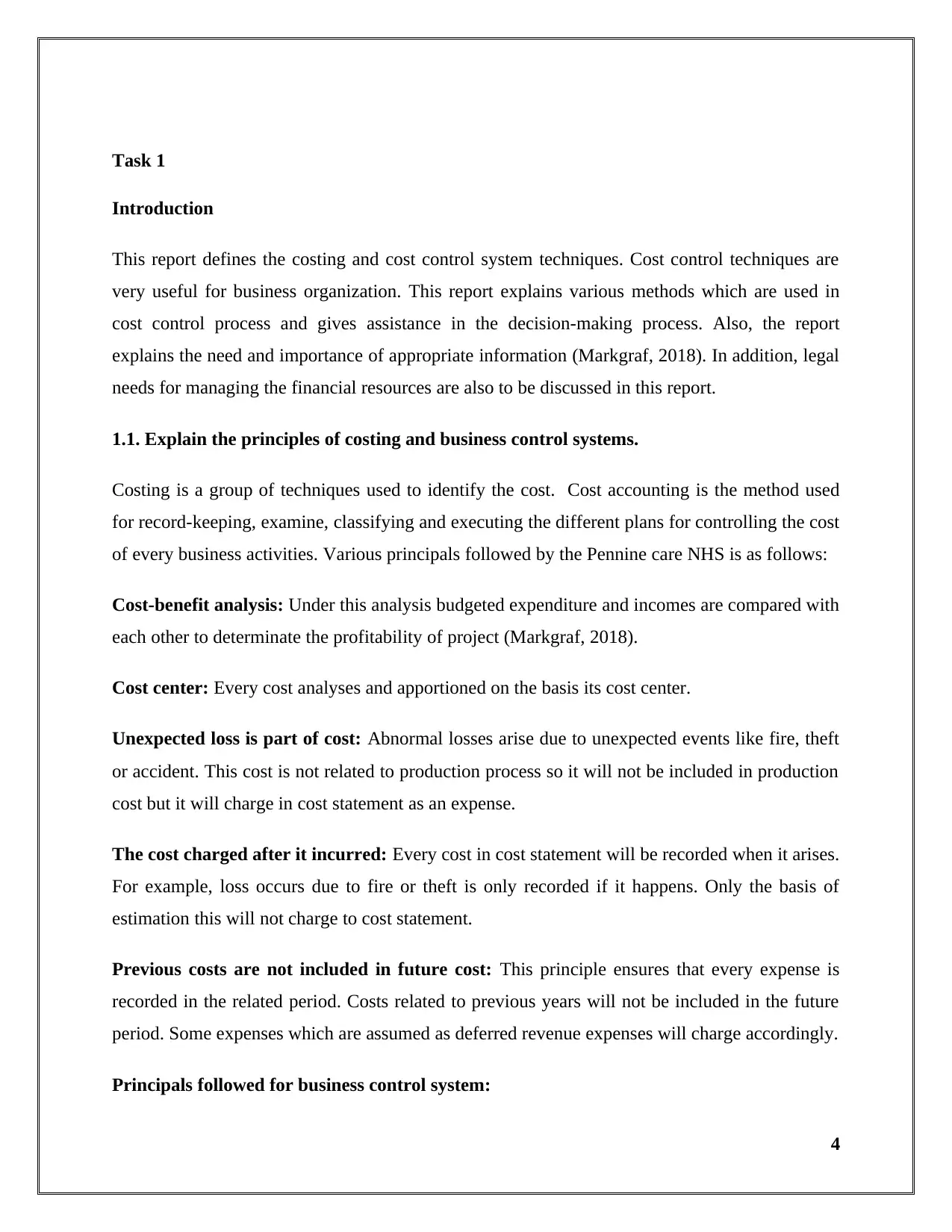
Task 1
Introduction
This report defines the costing and cost control system techniques. Cost control techniques are
very useful for business organization. This report explains various methods which are used in
cost control process and gives assistance in the decision-making process. Also, the report
explains the need and importance of appropriate information (Markgraf, 2018). In addition, legal
needs for managing the financial resources are also to be discussed in this report.
1.1. Explain the principles of costing and business control systems.
Costing is a group of techniques used to identify the cost. Cost accounting is the method used
for record-keeping, examine, classifying and executing the different plans for controlling the cost
of every business activities. Various principals followed by the Pennine care NHS is as follows:
Cost-benefit analysis: Under this analysis budgeted expenditure and incomes are compared with
each other to determinate the profitability of project (Markgraf, 2018).
Cost center: Every cost analyses and apportioned on the basis its cost center.
Unexpected loss is part of cost: Abnormal losses arise due to unexpected events like fire, theft
or accident. This cost is not related to production process so it will not be included in production
cost but it will charge in cost statement as an expense.
The cost charged after it incurred: Every cost in cost statement will be recorded when it arises.
For example, loss occurs due to fire or theft is only recorded if it happens. Only the basis of
estimation this will not charge to cost statement.
Previous costs are not included in future cost: This principle ensures that every expense is
recorded in the related period. Costs related to previous years will not be included in the future
period. Some expenses which are assumed as deferred revenue expenses will charge accordingly.
Principals followed for business control system:
4
Introduction
This report defines the costing and cost control system techniques. Cost control techniques are
very useful for business organization. This report explains various methods which are used in
cost control process and gives assistance in the decision-making process. Also, the report
explains the need and importance of appropriate information (Markgraf, 2018). In addition, legal
needs for managing the financial resources are also to be discussed in this report.
1.1. Explain the principles of costing and business control systems.
Costing is a group of techniques used to identify the cost. Cost accounting is the method used
for record-keeping, examine, classifying and executing the different plans for controlling the cost
of every business activities. Various principals followed by the Pennine care NHS is as follows:
Cost-benefit analysis: Under this analysis budgeted expenditure and incomes are compared with
each other to determinate the profitability of project (Markgraf, 2018).
Cost center: Every cost analyses and apportioned on the basis its cost center.
Unexpected loss is part of cost: Abnormal losses arise due to unexpected events like fire, theft
or accident. This cost is not related to production process so it will not be included in production
cost but it will charge in cost statement as an expense.
The cost charged after it incurred: Every cost in cost statement will be recorded when it arises.
For example, loss occurs due to fire or theft is only recorded if it happens. Only the basis of
estimation this will not charge to cost statement.
Previous costs are not included in future cost: This principle ensures that every expense is
recorded in the related period. Costs related to previous years will not be included in the future
period. Some expenses which are assumed as deferred revenue expenses will charge accordingly.
Principals followed for business control system:
4
Paraphrase This Document
Need a fresh take? Get an instant paraphrase of this document with our AI Paraphraser
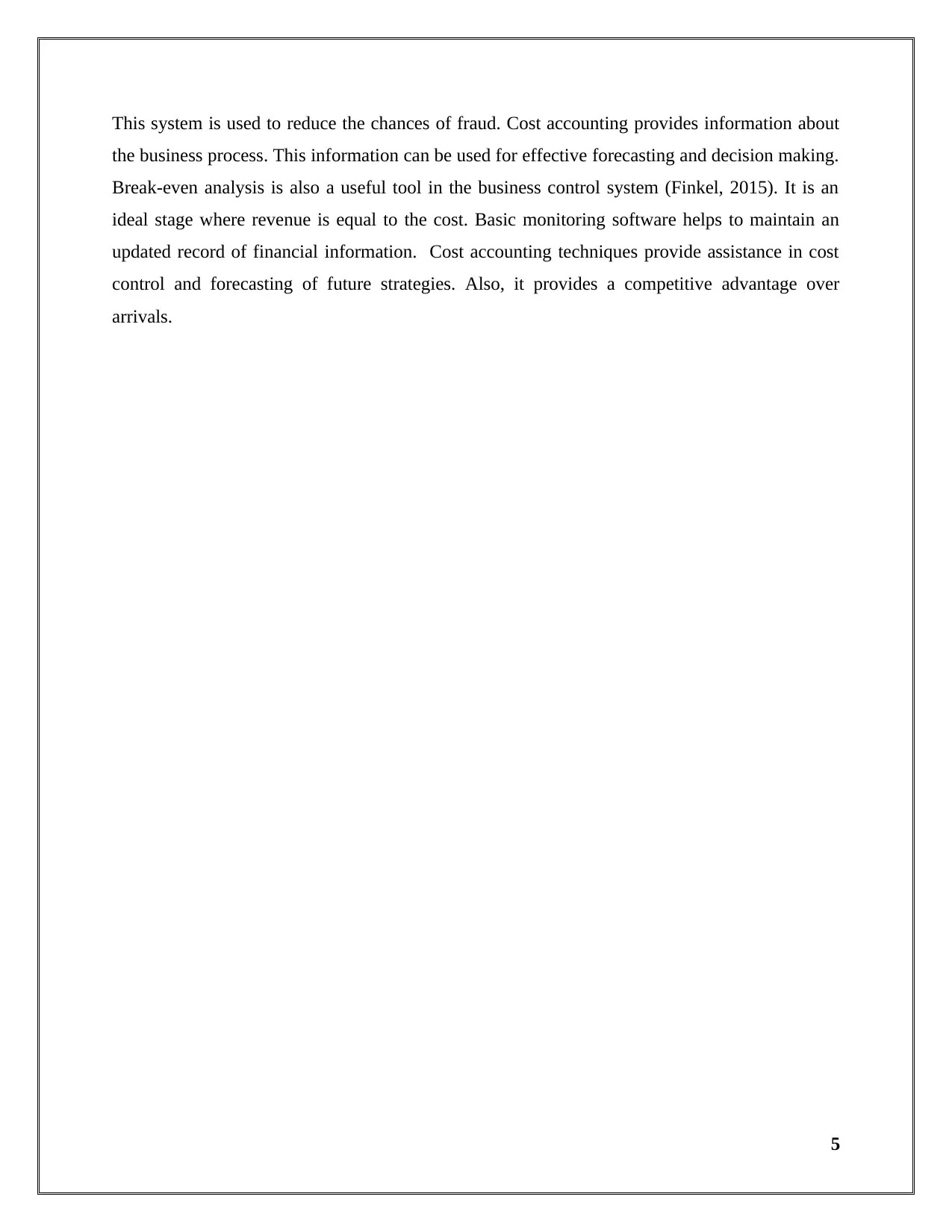
This system is used to reduce the chances of fraud. Cost accounting provides information about
the business process. This information can be used for effective forecasting and decision making.
Break-even analysis is also a useful tool in the business control system (Finkel, 2015). It is an
ideal stage where revenue is equal to the cost. Basic monitoring software helps to maintain an
updated record of financial information. Cost accounting techniques provide assistance in cost
control and forecasting of future strategies. Also, it provides a competitive advantage over
arrivals.
5
the business process. This information can be used for effective forecasting and decision making.
Break-even analysis is also a useful tool in the business control system (Finkel, 2015). It is an
ideal stage where revenue is equal to the cost. Basic monitoring software helps to maintain an
updated record of financial information. Cost accounting techniques provide assistance in cost
control and forecasting of future strategies. Also, it provides a competitive advantage over
arrivals.
5
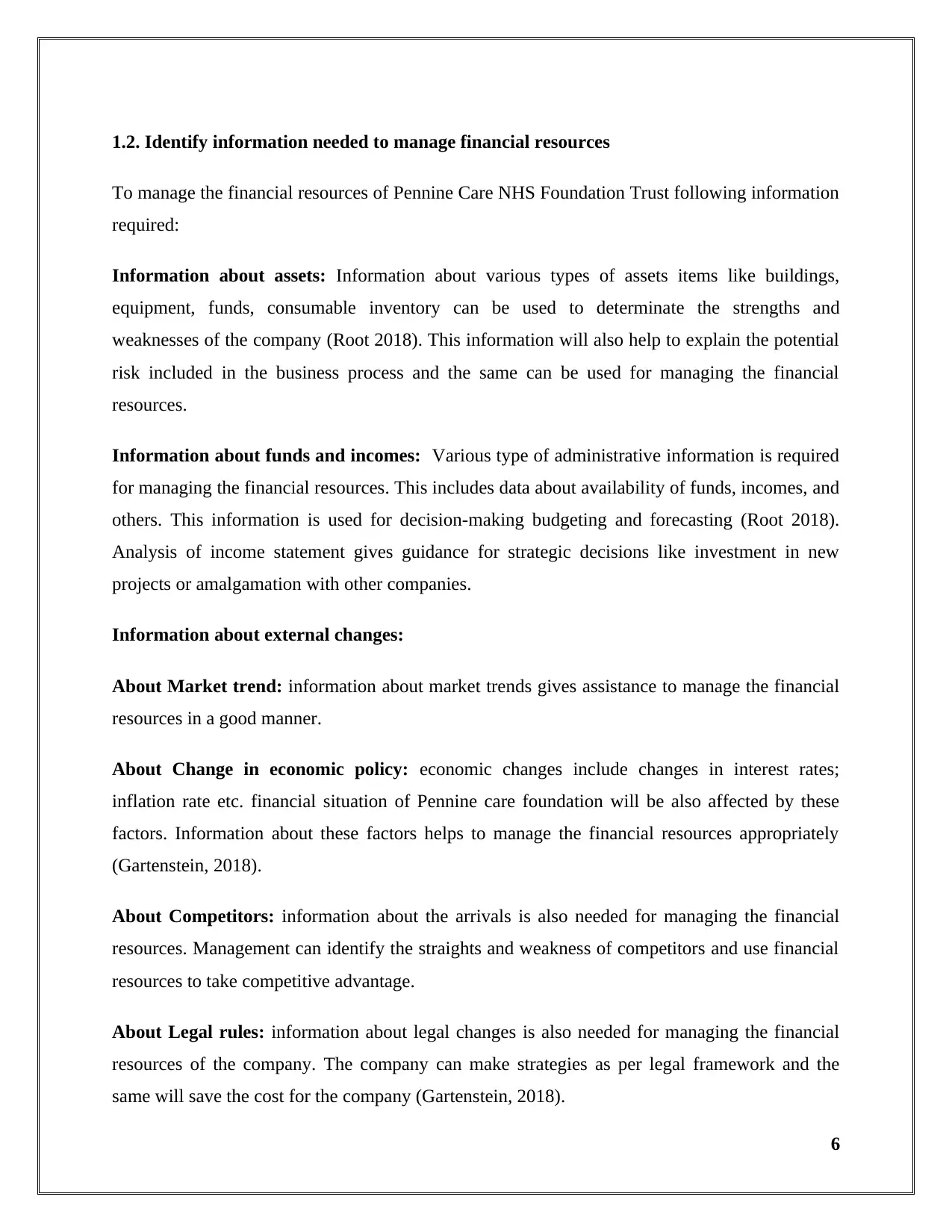
1.2. Identify information needed to manage financial resources
To manage the financial resources of Pennine Care NHS Foundation Trust following information
required:
Information about assets: Information about various types of assets items like buildings,
equipment, funds, consumable inventory can be used to determinate the strengths and
weaknesses of the company (Root 2018). This information will also help to explain the potential
risk included in the business process and the same can be used for managing the financial
resources.
Information about funds and incomes: Various type of administrative information is required
for managing the financial resources. This includes data about availability of funds, incomes, and
others. This information is used for decision-making budgeting and forecasting (Root 2018).
Analysis of income statement gives guidance for strategic decisions like investment in new
projects or amalgamation with other companies.
Information about external changes:
About Market trend: information about market trends gives assistance to manage the financial
resources in a good manner.
About Change in economic policy: economic changes include changes in interest rates;
inflation rate etc. financial situation of Pennine care foundation will be also affected by these
factors. Information about these factors helps to manage the financial resources appropriately
(Gartenstein, 2018).
About Competitors: information about the arrivals is also needed for managing the financial
resources. Management can identify the straights and weakness of competitors and use financial
resources to take competitive advantage.
About Legal rules: information about legal changes is also needed for managing the financial
resources of the company. The company can make strategies as per legal framework and the
same will save the cost for the company (Gartenstein, 2018).
6
To manage the financial resources of Pennine Care NHS Foundation Trust following information
required:
Information about assets: Information about various types of assets items like buildings,
equipment, funds, consumable inventory can be used to determinate the strengths and
weaknesses of the company (Root 2018). This information will also help to explain the potential
risk included in the business process and the same can be used for managing the financial
resources.
Information about funds and incomes: Various type of administrative information is required
for managing the financial resources. This includes data about availability of funds, incomes, and
others. This information is used for decision-making budgeting and forecasting (Root 2018).
Analysis of income statement gives guidance for strategic decisions like investment in new
projects or amalgamation with other companies.
Information about external changes:
About Market trend: information about market trends gives assistance to manage the financial
resources in a good manner.
About Change in economic policy: economic changes include changes in interest rates;
inflation rate etc. financial situation of Pennine care foundation will be also affected by these
factors. Information about these factors helps to manage the financial resources appropriately
(Gartenstein, 2018).
About Competitors: information about the arrivals is also needed for managing the financial
resources. Management can identify the straights and weakness of competitors and use financial
resources to take competitive advantage.
About Legal rules: information about legal changes is also needed for managing the financial
resources of the company. The company can make strategies as per legal framework and the
same will save the cost for the company (Gartenstein, 2018).
6
⊘ This is a preview!⊘
Do you want full access?
Subscribe today to unlock all pages.

Trusted by 1+ million students worldwide
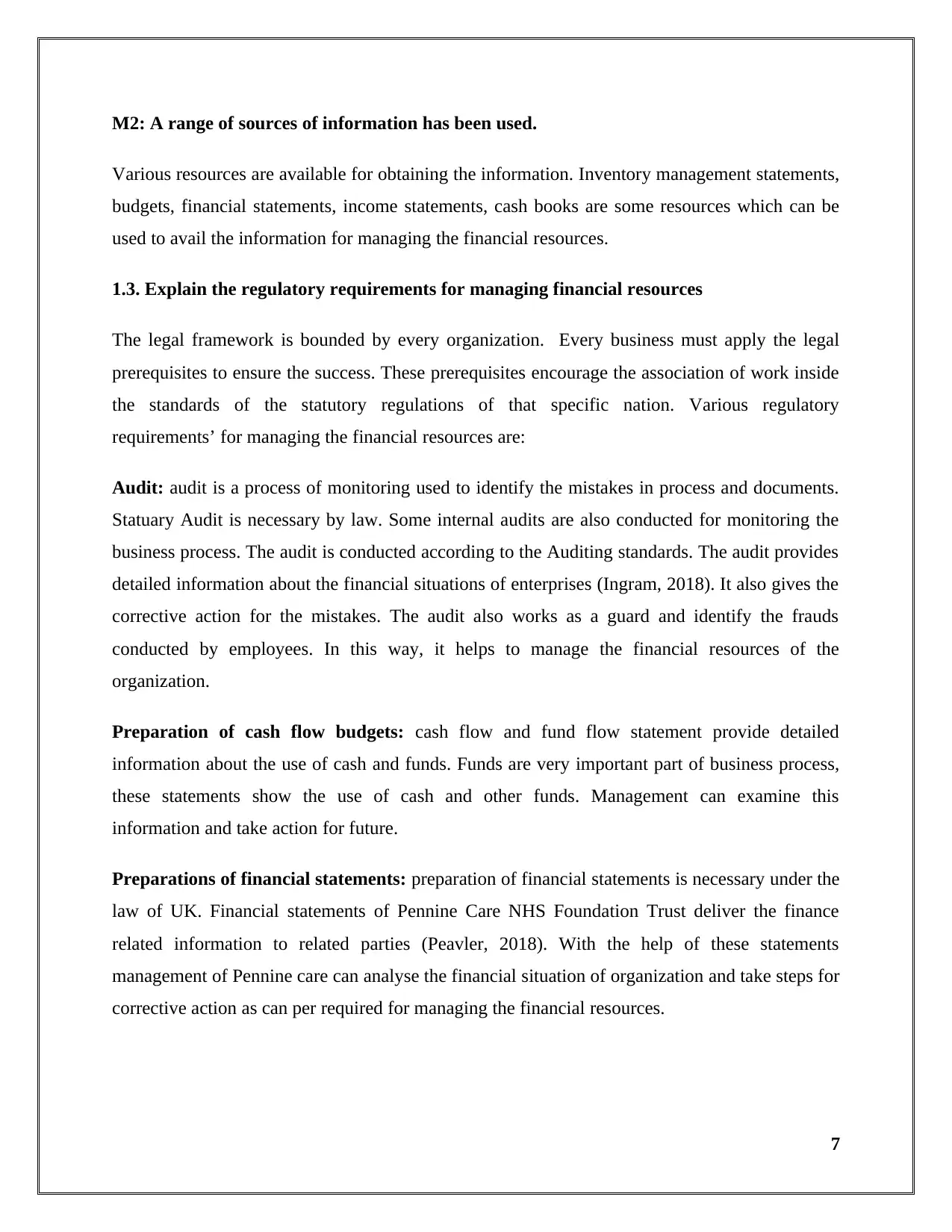
M2: A range of sources of information has been used.
Various resources are available for obtaining the information. Inventory management statements,
budgets, financial statements, income statements, cash books are some resources which can be
used to avail the information for managing the financial resources.
1.3. Explain the regulatory requirements for managing financial resources
The legal framework is bounded by every organization. Every business must apply the legal
prerequisites to ensure the success. These prerequisites encourage the association of work inside
the standards of the statutory regulations of that specific nation. Various regulatory
requirements’ for managing the financial resources are:
Audit: audit is a process of monitoring used to identify the mistakes in process and documents.
Statuary Audit is necessary by law. Some internal audits are also conducted for monitoring the
business process. The audit is conducted according to the Auditing standards. The audit provides
detailed information about the financial situations of enterprises (Ingram, 2018). It also gives the
corrective action for the mistakes. The audit also works as a guard and identify the frauds
conducted by employees. In this way, it helps to manage the financial resources of the
organization.
Preparation of cash flow budgets: cash flow and fund flow statement provide detailed
information about the use of cash and funds. Funds are very important part of business process,
these statements show the use of cash and other funds. Management can examine this
information and take action for future.
Preparations of financial statements: preparation of financial statements is necessary under the
law of UK. Financial statements of Pennine Care NHS Foundation Trust deliver the finance
related information to related parties (Peavler, 2018). With the help of these statements
management of Pennine care can analyse the financial situation of organization and take steps for
corrective action as can per required for managing the financial resources.
7
Various resources are available for obtaining the information. Inventory management statements,
budgets, financial statements, income statements, cash books are some resources which can be
used to avail the information for managing the financial resources.
1.3. Explain the regulatory requirements for managing financial resources
The legal framework is bounded by every organization. Every business must apply the legal
prerequisites to ensure the success. These prerequisites encourage the association of work inside
the standards of the statutory regulations of that specific nation. Various regulatory
requirements’ for managing the financial resources are:
Audit: audit is a process of monitoring used to identify the mistakes in process and documents.
Statuary Audit is necessary by law. Some internal audits are also conducted for monitoring the
business process. The audit is conducted according to the Auditing standards. The audit provides
detailed information about the financial situations of enterprises (Ingram, 2018). It also gives the
corrective action for the mistakes. The audit also works as a guard and identify the frauds
conducted by employees. In this way, it helps to manage the financial resources of the
organization.
Preparation of cash flow budgets: cash flow and fund flow statement provide detailed
information about the use of cash and funds. Funds are very important part of business process,
these statements show the use of cash and other funds. Management can examine this
information and take action for future.
Preparations of financial statements: preparation of financial statements is necessary under the
law of UK. Financial statements of Pennine Care NHS Foundation Trust deliver the finance
related information to related parties (Peavler, 2018). With the help of these statements
management of Pennine care can analyse the financial situation of organization and take steps for
corrective action as can per required for managing the financial resources.
7
Paraphrase This Document
Need a fresh take? Get an instant paraphrase of this document with our AI Paraphraser
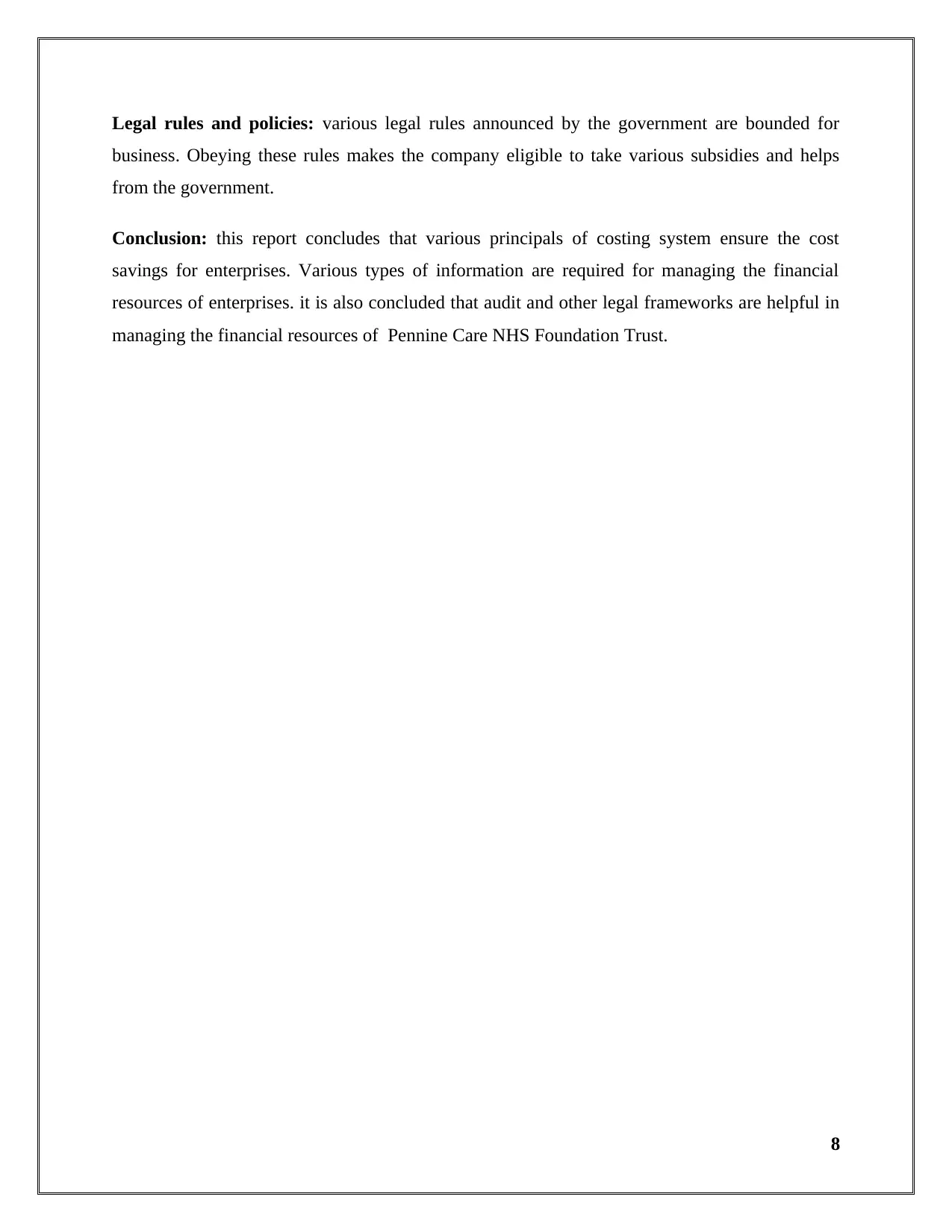
Legal rules and policies: various legal rules announced by the government are bounded for
business. Obeying these rules makes the company eligible to take various subsidies and helps
from the government.
Conclusion: this report concludes that various principals of costing system ensure the cost
savings for enterprises. Various types of information are required for managing the financial
resources of enterprises. it is also concluded that audit and other legal frameworks are helpful in
managing the financial resources of Pennine Care NHS Foundation Trust.
8
business. Obeying these rules makes the company eligible to take various subsidies and helps
from the government.
Conclusion: this report concludes that various principals of costing system ensure the cost
savings for enterprises. Various types of information are required for managing the financial
resources of enterprises. it is also concluded that audit and other legal frameworks are helpful in
managing the financial resources of Pennine Care NHS Foundation Trust.
8
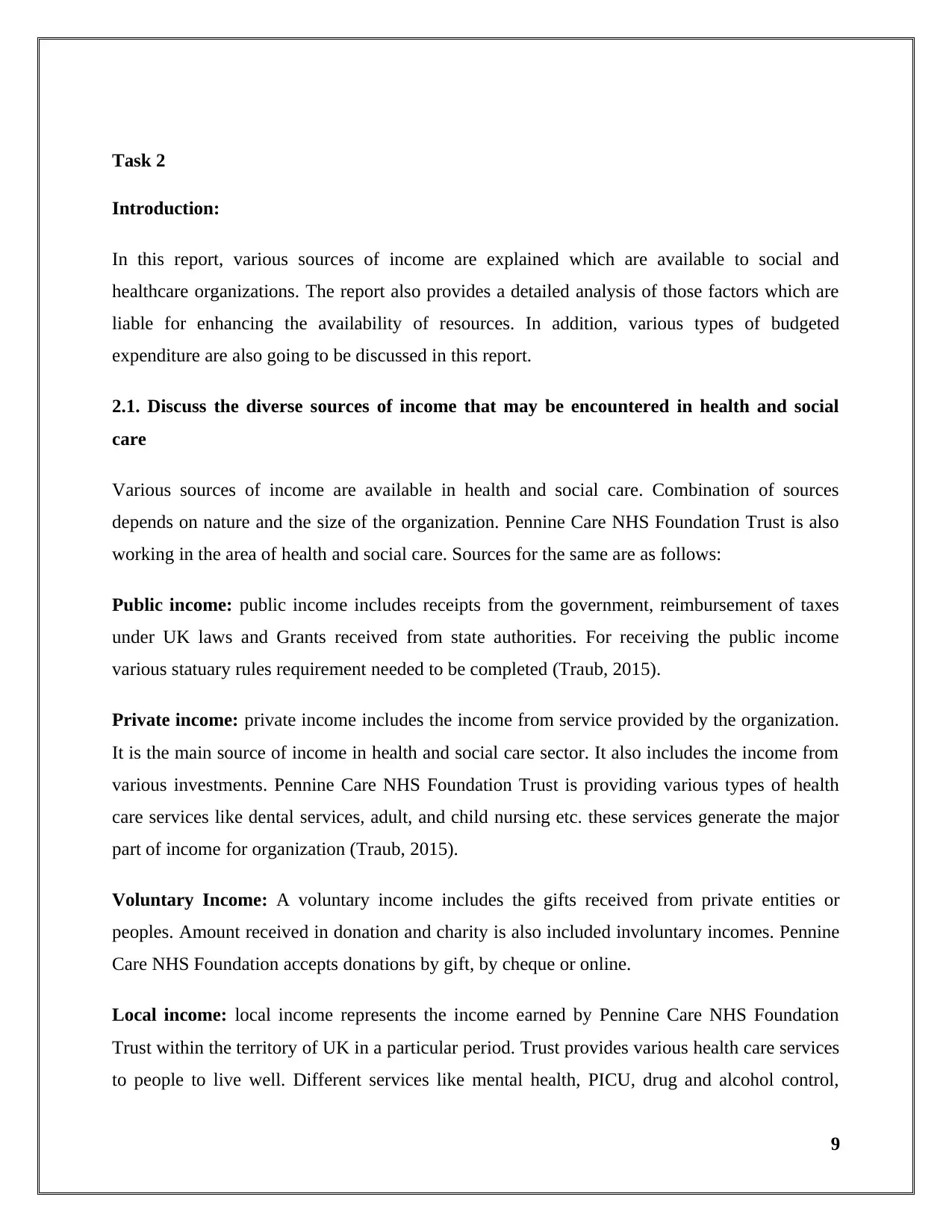
Task 2
Introduction:
In this report, various sources of income are explained which are available to social and
healthcare organizations. The report also provides a detailed analysis of those factors which are
liable for enhancing the availability of resources. In addition, various types of budgeted
expenditure are also going to be discussed in this report.
2.1. Discuss the diverse sources of income that may be encountered in health and social
care
Various sources of income are available in health and social care. Combination of sources
depends on nature and the size of the organization. Pennine Care NHS Foundation Trust is also
working in the area of health and social care. Sources for the same are as follows:
Public income: public income includes receipts from the government, reimbursement of taxes
under UK laws and Grants received from state authorities. For receiving the public income
various statuary rules requirement needed to be completed (Traub, 2015).
Private income: private income includes the income from service provided by the organization.
It is the main source of income in health and social care sector. It also includes the income from
various investments. Pennine Care NHS Foundation Trust is providing various types of health
care services like dental services, adult, and child nursing etc. these services generate the major
part of income for organization (Traub, 2015).
Voluntary Income: A voluntary income includes the gifts received from private entities or
peoples. Amount received in donation and charity is also included involuntary incomes. Pennine
Care NHS Foundation accepts donations by gift, by cheque or online.
Local income: local income represents the income earned by Pennine Care NHS Foundation
Trust within the territory of UK in a particular period. Trust provides various health care services
to people to live well. Different services like mental health, PICU, drug and alcohol control,
9
Introduction:
In this report, various sources of income are explained which are available to social and
healthcare organizations. The report also provides a detailed analysis of those factors which are
liable for enhancing the availability of resources. In addition, various types of budgeted
expenditure are also going to be discussed in this report.
2.1. Discuss the diverse sources of income that may be encountered in health and social
care
Various sources of income are available in health and social care. Combination of sources
depends on nature and the size of the organization. Pennine Care NHS Foundation Trust is also
working in the area of health and social care. Sources for the same are as follows:
Public income: public income includes receipts from the government, reimbursement of taxes
under UK laws and Grants received from state authorities. For receiving the public income
various statuary rules requirement needed to be completed (Traub, 2015).
Private income: private income includes the income from service provided by the organization.
It is the main source of income in health and social care sector. It also includes the income from
various investments. Pennine Care NHS Foundation Trust is providing various types of health
care services like dental services, adult, and child nursing etc. these services generate the major
part of income for organization (Traub, 2015).
Voluntary Income: A voluntary income includes the gifts received from private entities or
peoples. Amount received in donation and charity is also included involuntary incomes. Pennine
Care NHS Foundation accepts donations by gift, by cheque or online.
Local income: local income represents the income earned by Pennine Care NHS Foundation
Trust within the territory of UK in a particular period. Trust provides various health care services
to people to live well. Different services like mental health, PICU, drug and alcohol control,
9
⊘ This is a preview!⊘
Do you want full access?
Subscribe today to unlock all pages.

Trusted by 1+ million students worldwide
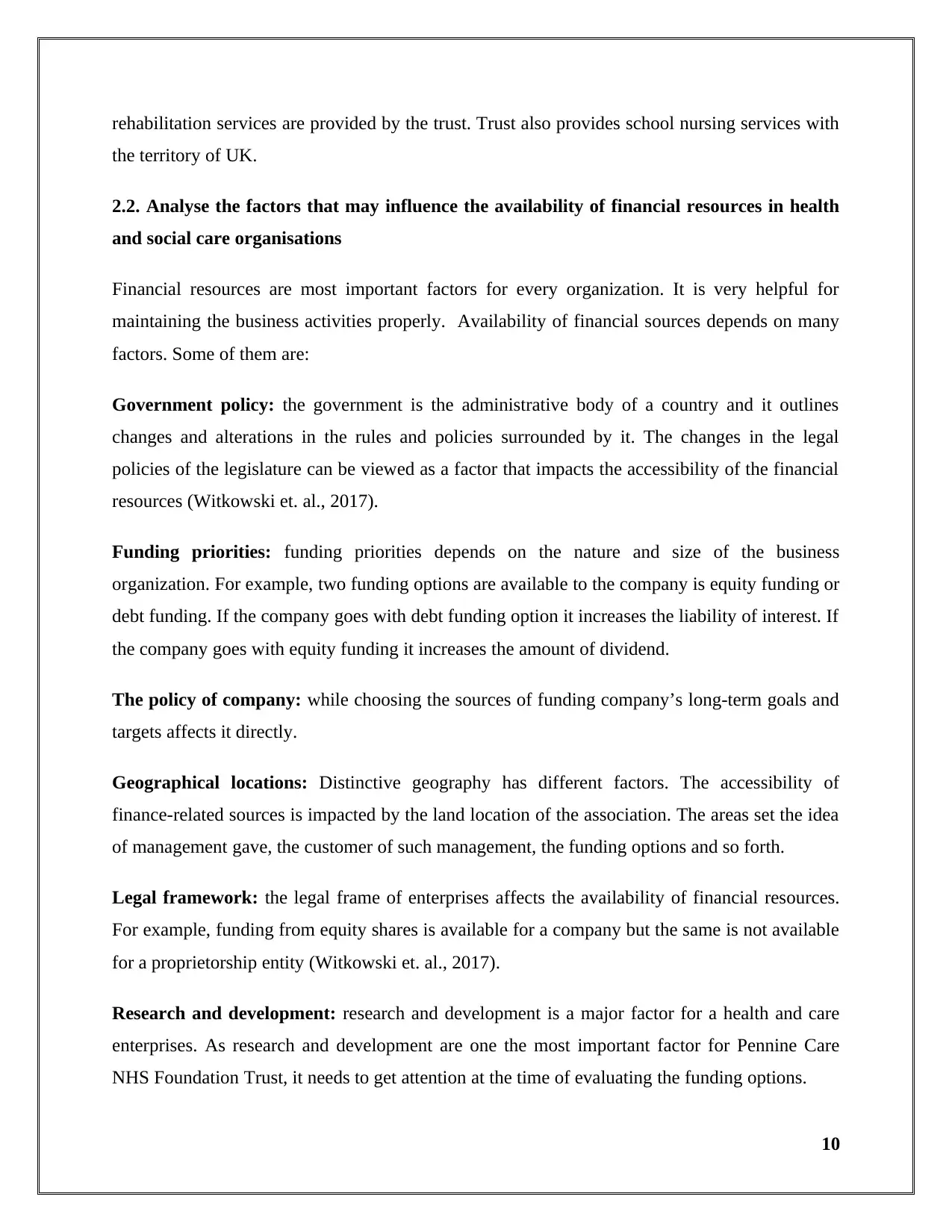
rehabilitation services are provided by the trust. Trust also provides school nursing services with
the territory of UK.
2.2. Analyse the factors that may influence the availability of financial resources in health
and social care organisations
Financial resources are most important factors for every organization. It is very helpful for
maintaining the business activities properly. Availability of financial sources depends on many
factors. Some of them are:
Government policy: the government is the administrative body of a country and it outlines
changes and alterations in the rules and policies surrounded by it. The changes in the legal
policies of the legislature can be viewed as a factor that impacts the accessibility of the financial
resources (Witkowski et. al., 2017).
Funding priorities: funding priorities depends on the nature and size of the business
organization. For example, two funding options are available to the company is equity funding or
debt funding. If the company goes with debt funding option it increases the liability of interest. If
the company goes with equity funding it increases the amount of dividend.
The policy of company: while choosing the sources of funding company’s long-term goals and
targets affects it directly.
Geographical locations: Distinctive geography has different factors. The accessibility of
finance-related sources is impacted by the land location of the association. The areas set the idea
of management gave, the customer of such management, the funding options and so forth.
Legal framework: the legal frame of enterprises affects the availability of financial resources.
For example, funding from equity shares is available for a company but the same is not available
for a proprietorship entity (Witkowski et. al., 2017).
Research and development: research and development is a major factor for a health and care
enterprises. As research and development are one the most important factor for Pennine Care
NHS Foundation Trust, it needs to get attention at the time of evaluating the funding options.
10
the territory of UK.
2.2. Analyse the factors that may influence the availability of financial resources in health
and social care organisations
Financial resources are most important factors for every organization. It is very helpful for
maintaining the business activities properly. Availability of financial sources depends on many
factors. Some of them are:
Government policy: the government is the administrative body of a country and it outlines
changes and alterations in the rules and policies surrounded by it. The changes in the legal
policies of the legislature can be viewed as a factor that impacts the accessibility of the financial
resources (Witkowski et. al., 2017).
Funding priorities: funding priorities depends on the nature and size of the business
organization. For example, two funding options are available to the company is equity funding or
debt funding. If the company goes with debt funding option it increases the liability of interest. If
the company goes with equity funding it increases the amount of dividend.
The policy of company: while choosing the sources of funding company’s long-term goals and
targets affects it directly.
Geographical locations: Distinctive geography has different factors. The accessibility of
finance-related sources is impacted by the land location of the association. The areas set the idea
of management gave, the customer of such management, the funding options and so forth.
Legal framework: the legal frame of enterprises affects the availability of financial resources.
For example, funding from equity shares is available for a company but the same is not available
for a proprietorship entity (Witkowski et. al., 2017).
Research and development: research and development is a major factor for a health and care
enterprises. As research and development are one the most important factor for Pennine Care
NHS Foundation Trust, it needs to get attention at the time of evaluating the funding options.
10
Paraphrase This Document
Need a fresh take? Get an instant paraphrase of this document with our AI Paraphraser
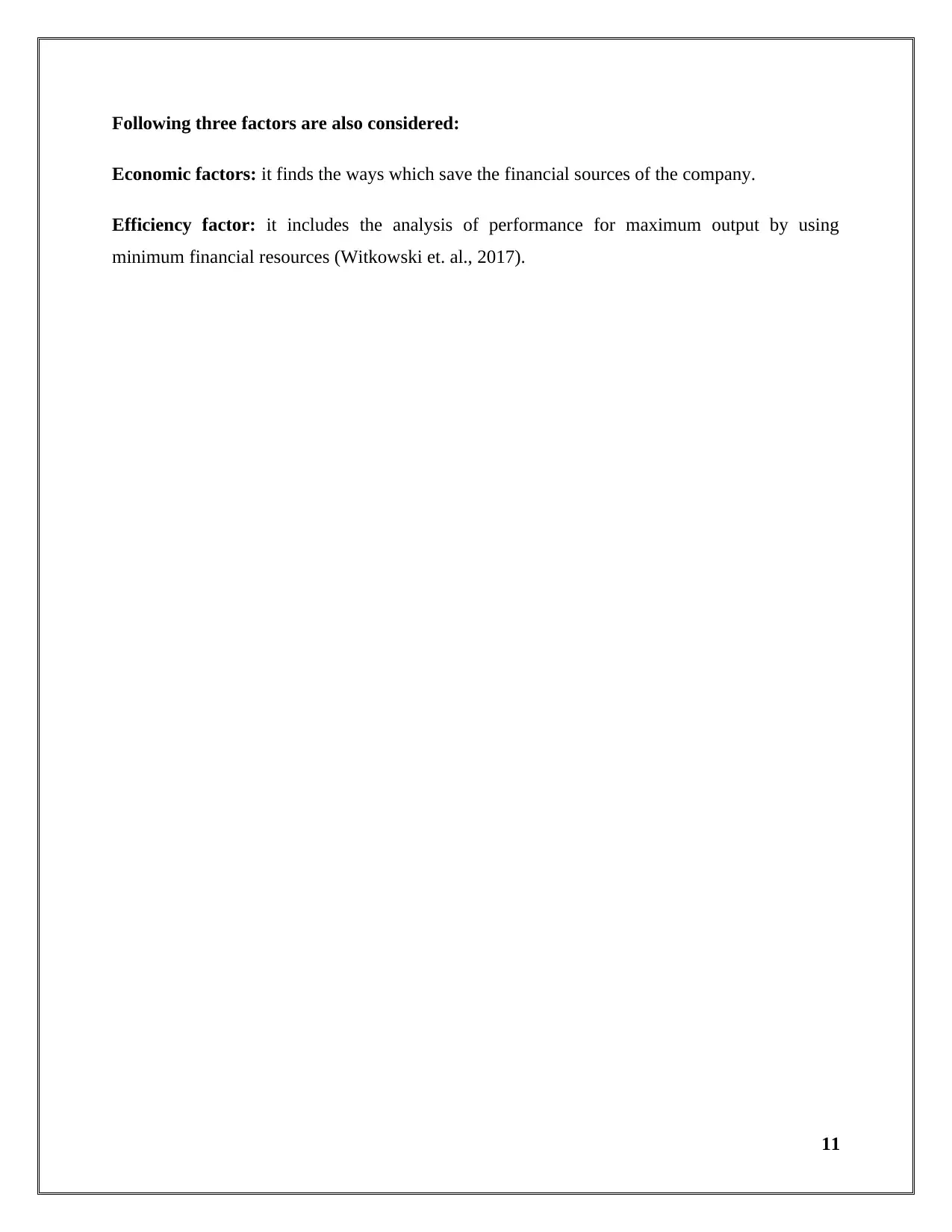
Following three factors are also considered:
Economic factors: it finds the ways which save the financial sources of the company.
Efficiency factor: it includes the analysis of performance for maximum output by using
minimum financial resources (Witkowski et. al., 2017).
11
Economic factors: it finds the ways which save the financial sources of the company.
Efficiency factor: it includes the analysis of performance for maximum output by using
minimum financial resources (Witkowski et. al., 2017).
11
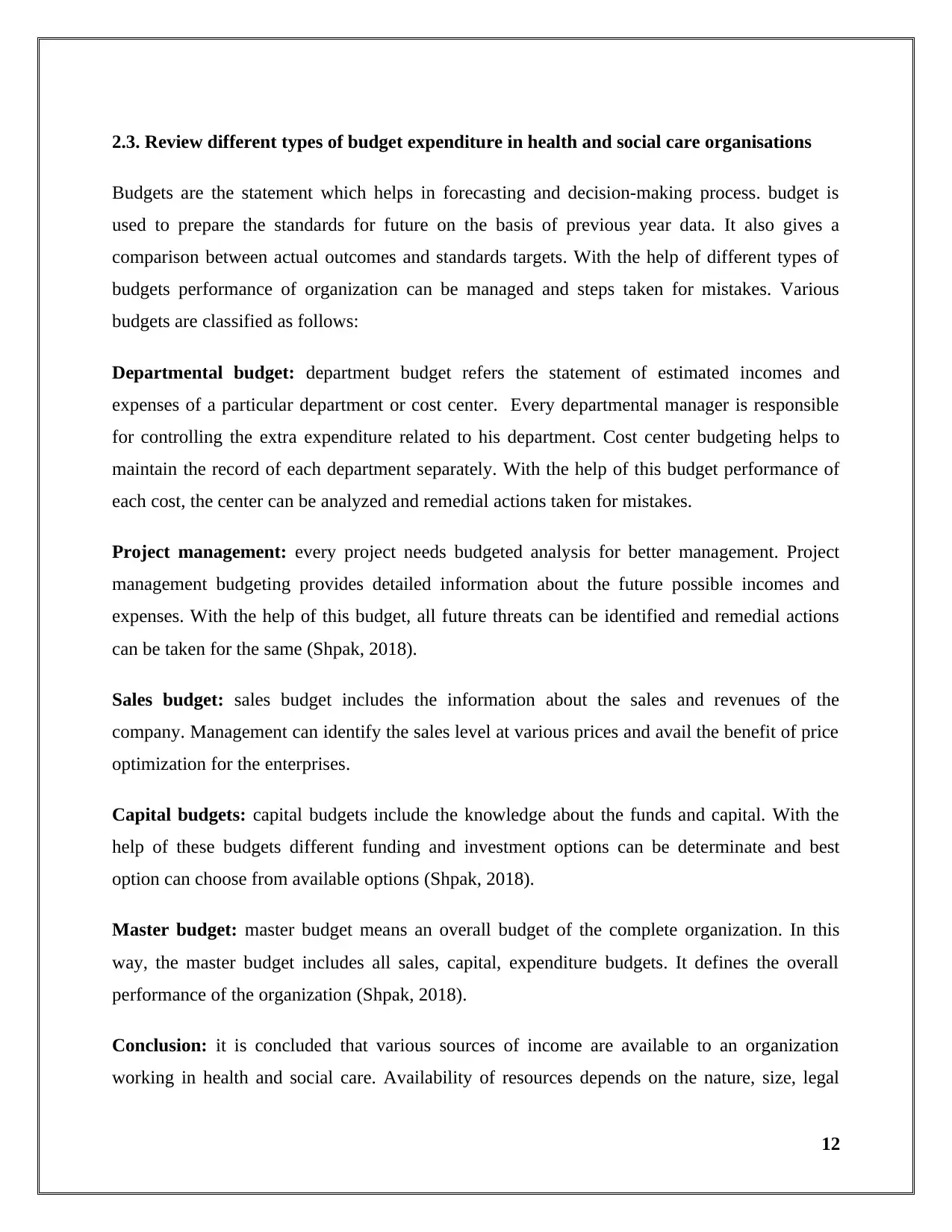
2.3. Review different types of budget expenditure in health and social care organisations
Budgets are the statement which helps in forecasting and decision-making process. budget is
used to prepare the standards for future on the basis of previous year data. It also gives a
comparison between actual outcomes and standards targets. With the help of different types of
budgets performance of organization can be managed and steps taken for mistakes. Various
budgets are classified as follows:
Departmental budget: department budget refers the statement of estimated incomes and
expenses of a particular department or cost center. Every departmental manager is responsible
for controlling the extra expenditure related to his department. Cost center budgeting helps to
maintain the record of each department separately. With the help of this budget performance of
each cost, the center can be analyzed and remedial actions taken for mistakes.
Project management: every project needs budgeted analysis for better management. Project
management budgeting provides detailed information about the future possible incomes and
expenses. With the help of this budget, all future threats can be identified and remedial actions
can be taken for the same (Shpak, 2018).
Sales budget: sales budget includes the information about the sales and revenues of the
company. Management can identify the sales level at various prices and avail the benefit of price
optimization for the enterprises.
Capital budgets: capital budgets include the knowledge about the funds and capital. With the
help of these budgets different funding and investment options can be determinate and best
option can choose from available options (Shpak, 2018).
Master budget: master budget means an overall budget of the complete organization. In this
way, the master budget includes all sales, capital, expenditure budgets. It defines the overall
performance of the organization (Shpak, 2018).
Conclusion: it is concluded that various sources of income are available to an organization
working in health and social care. Availability of resources depends on the nature, size, legal
12
Budgets are the statement which helps in forecasting and decision-making process. budget is
used to prepare the standards for future on the basis of previous year data. It also gives a
comparison between actual outcomes and standards targets. With the help of different types of
budgets performance of organization can be managed and steps taken for mistakes. Various
budgets are classified as follows:
Departmental budget: department budget refers the statement of estimated incomes and
expenses of a particular department or cost center. Every departmental manager is responsible
for controlling the extra expenditure related to his department. Cost center budgeting helps to
maintain the record of each department separately. With the help of this budget performance of
each cost, the center can be analyzed and remedial actions taken for mistakes.
Project management: every project needs budgeted analysis for better management. Project
management budgeting provides detailed information about the future possible incomes and
expenses. With the help of this budget, all future threats can be identified and remedial actions
can be taken for the same (Shpak, 2018).
Sales budget: sales budget includes the information about the sales and revenues of the
company. Management can identify the sales level at various prices and avail the benefit of price
optimization for the enterprises.
Capital budgets: capital budgets include the knowledge about the funds and capital. With the
help of these budgets different funding and investment options can be determinate and best
option can choose from available options (Shpak, 2018).
Master budget: master budget means an overall budget of the complete organization. In this
way, the master budget includes all sales, capital, expenditure budgets. It defines the overall
performance of the organization (Shpak, 2018).
Conclusion: it is concluded that various sources of income are available to an organization
working in health and social care. Availability of resources depends on the nature, size, legal
12
⊘ This is a preview!⊘
Do you want full access?
Subscribe today to unlock all pages.

Trusted by 1+ million students worldwide
1 out of 23
Related Documents
Your All-in-One AI-Powered Toolkit for Academic Success.
+13062052269
info@desklib.com
Available 24*7 on WhatsApp / Email
![[object Object]](/_next/static/media/star-bottom.7253800d.svg)
Unlock your academic potential
Copyright © 2020–2025 A2Z Services. All Rights Reserved. Developed and managed by ZUCOL.





